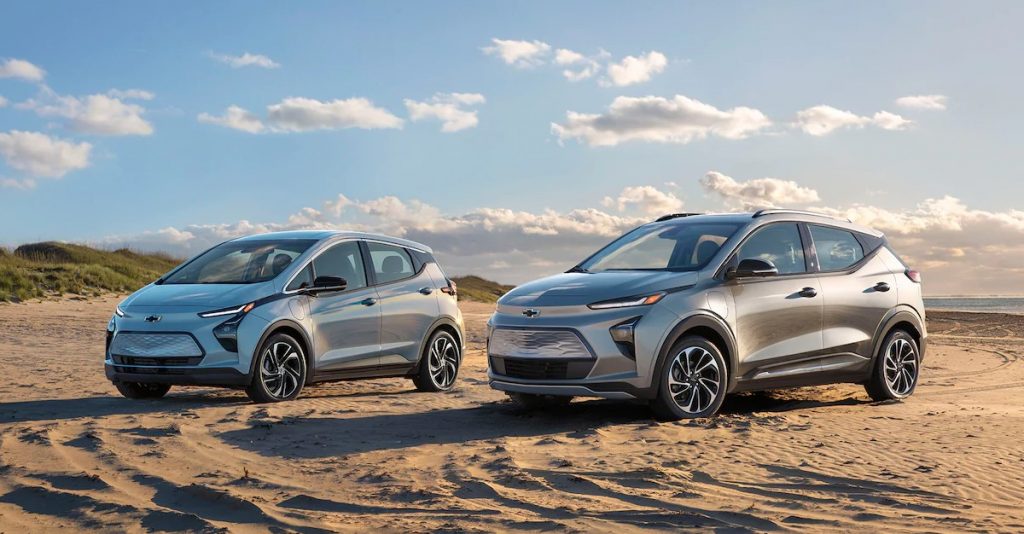
This morning Chevrolet, a division of General Motors, announced a refresh to the all-electric Bolt. The car began production back in 2017, so 4 years on, it was definitely time for an update, particularly given how far battery technology has come since then.
Back in March this year, GM made a big splash with the announcement they were creating a new Ultium battery platform, flexible enough to suit basically any vehicle type, with energy options from 50 to 200kWh in size and feature DC fast charging up t o 350kW.
The problem is, the refreshed Bolt doesn’t the new Ultium platform, instead it’s an incredibly incremental change to the original Bolt, making for a very disappointing offering.
The small car market has a big opportunity in the EV space to deliver the lowest prices and be the gateway for many families to add an EV to their garage. Unfortunately the specs and price of the new bolt and bolt SUV are not in line with current industry offerings. By the way, I hate that Chevy are calling this an Electric Utility Vehicle, its a small SUV, there’s no reason to rename a category because the power plant changes.
Design-wise I think the refresh has certainly modernised the car and I think the EUV actually looks the better choice of the two. While I don’t think anyone should plan to actually take it off-road, with a higher ride height and more storage, it does seem like the more obvious choice.


The 2022 Bolt EV starts at US$31,995, while the EUV starts at US$33,995. The launch edition of the Bolt EUV is available to reserve now (for US$100) and starts at an MSRP of US$43,495. As for when these will be available, we’re looking at the first EUVs being on the road in Summer 2021, around 6-9 months from now.
So in Aussie dollaroos, that starting price converts to A$41,205.25 + 10% GST – $45,325 before on-roads (usually a few thousand more). For a small car that normally costs A$20-25k its a real stretch to ask almost twice that, just because its EV. By comparison, you could by the MG ZS EV (Compact SUV) for A$43,990 driveaway.
In the US Market, you can get into a Tesla Model 3 for US$36,490, just $5k for a mid-sized premium sedan with Autopilot and the option to buy FSD.
While reservations are being taken through the website, the purchasing will still use the legacy model of going through dealerships. More commonly automakers are turning to online sales, from your phone or computer, but it seems GM’s not quite ready for that.


Technology
Inside the vehicle will now see a range of technology updates.
Chevy Safety Assist comes standard on both Bolt EUV and Bolt EV and includes safety and advanced driver assistance technologies, such as Automatic Emergency Braking, Forward Collision Alert, Lane Keep Assist with Lane Departure Warning, Following Distance Indicator, IntelliBeam and Front Pedestrian Braking.
Available driver assistance technologies (that means optional extra) for both vehicles include Rear Cross Traffic Alert, HD Surround Vision and Adaptive Cruise Control. HD Rear Vision Camera is standard on both Bolt EUV and Bolt EV. The fact ACC is not standard is a bit of a joke in 2021/2022 and I can’t recommend anyone buy a car without it.
The Bolt EUV and Bolt EV will support wireless Apple CarPlay and Android Auto phone projection capability, as well as wireless phone charging as standard on Bolt EUV and available on Bolt EV, and an available 4G LTE Wi-Fi Hotspot.
Amazon’s Alexa and Spotify music streaming services are among the apps that are now available in-car. With Alexa, drivers can use simple voice commands, while keeping their eyes on the road and their hands on the wheel. Alexa can play music, get directions, place calls, listen to audiobooks, control your smart home, access tens of thousands of Alexa skills.
Range and charging
One good aspect of the announcement today is when it comes to home charging. If you purchase before June 31st 2021, Chevrolet plans to cover standard installation of Level 2 charging capability (11kW).
Additionally, DC fast public charging enables the Bolt EV to add up to 100 miles (160 km) of range in 30 minutes and 95 miles (152 km) for Bolt EUV. In that same timeframe, most modern EVs, can charge from 10-80% and add 3-400km of range.
Inside the Bolt is a 65 kWh, lithium-ion battery pack that gives a GM-estimated 259 miles of range (416 km) on a full charge. The slightly larger Bolt EUV, is expected to get 250 miles (402 km) on a charge. Those range numbers are decent, but in no way will correlate with EPA or WLTP figures.


The cheapest way to get Super Cruise
Previously GM’s Super Cruise technology that allows drivers to take their hands off the wheel (during very select highway driving), was only available on high-end vehicles like their Cadillac brand. This is being expanded to 22 vehicles by 2023 and the Bolt EUV is the cheapest way to get into a car with the driver assistance tech.
If you think this means you can use your phone, think again, Chevy clearly state ‘Do not use a hand-held device.’ While GM’s Super Cruise is a great driver assist, it isn’t autonomous driving, you need to be ready to take over at any stage. The system monitors drivers attention levels and should you fail to pay attention, the system will disengage.
Overall its really disappointing to see a new EV announced from a GM brand, that doesn’t use their new Ultium battery platform. Not only will it deliver better range and faster performance, it’s also go the capacity to actually charge fast, like a modern EV should.
It may be simply a clash of timelines between Chevy and GM, or a case of GM holding off the introduction of their platform in a premium car, the GMC Hummer.
